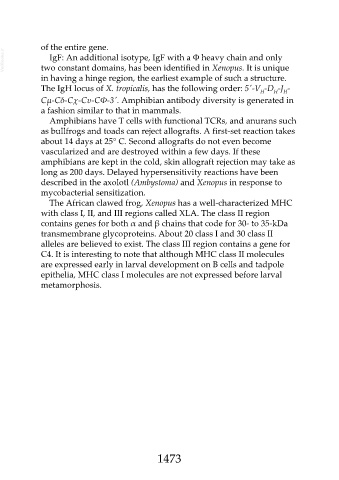Page 1473 - Veterinary Immunology, 10th Edition
P. 1473
of the entire gene.
VetBooks.ir two constant domains, has been identified in Xenopus. It is unique
IgF: An additional isotype, IgF with a Φ heavy chain and only
in having a hinge region, the earliest example of such a structure.
The IgH locus of X. tropicalis, has the following order: 5′-V -D -J -
H
H
H
Cµ-Cδ-Cχ-Cυ-CΦ-3′. Amphibian antibody diversity is generated in
a fashion similar to that in mammals.
Amphibians have T cells with functional TCRs, and anurans such
as bullfrogs and toads can reject allografts. A first-set reaction takes
about 14 days at 25° C. Second allografts do not even become
vascularized and are destroyed within a few days. If these
amphibians are kept in the cold, skin allograft rejection may take as
long as 200 days. Delayed hypersensitivity reactions have been
described in the axolotl (Ambystoma) and Xenopus in response to
mycobacterial sensitization.
The African clawed frog, Xenopus has a well-characterized MHC
with class I, II, and III regions called XLA. The class II region
contains genes for both α and β chains that code for 30- to 35-kDa
transmembrane glycoproteins. About 20 class I and 30 class II
alleles are believed to exist. The class III region contains a gene for
C4. It is interesting to note that although MHC class II molecules
are expressed early in larval development on B cells and tadpole
epithelia, MHC class I molecules are not expressed before larval
metamorphosis.
1473

